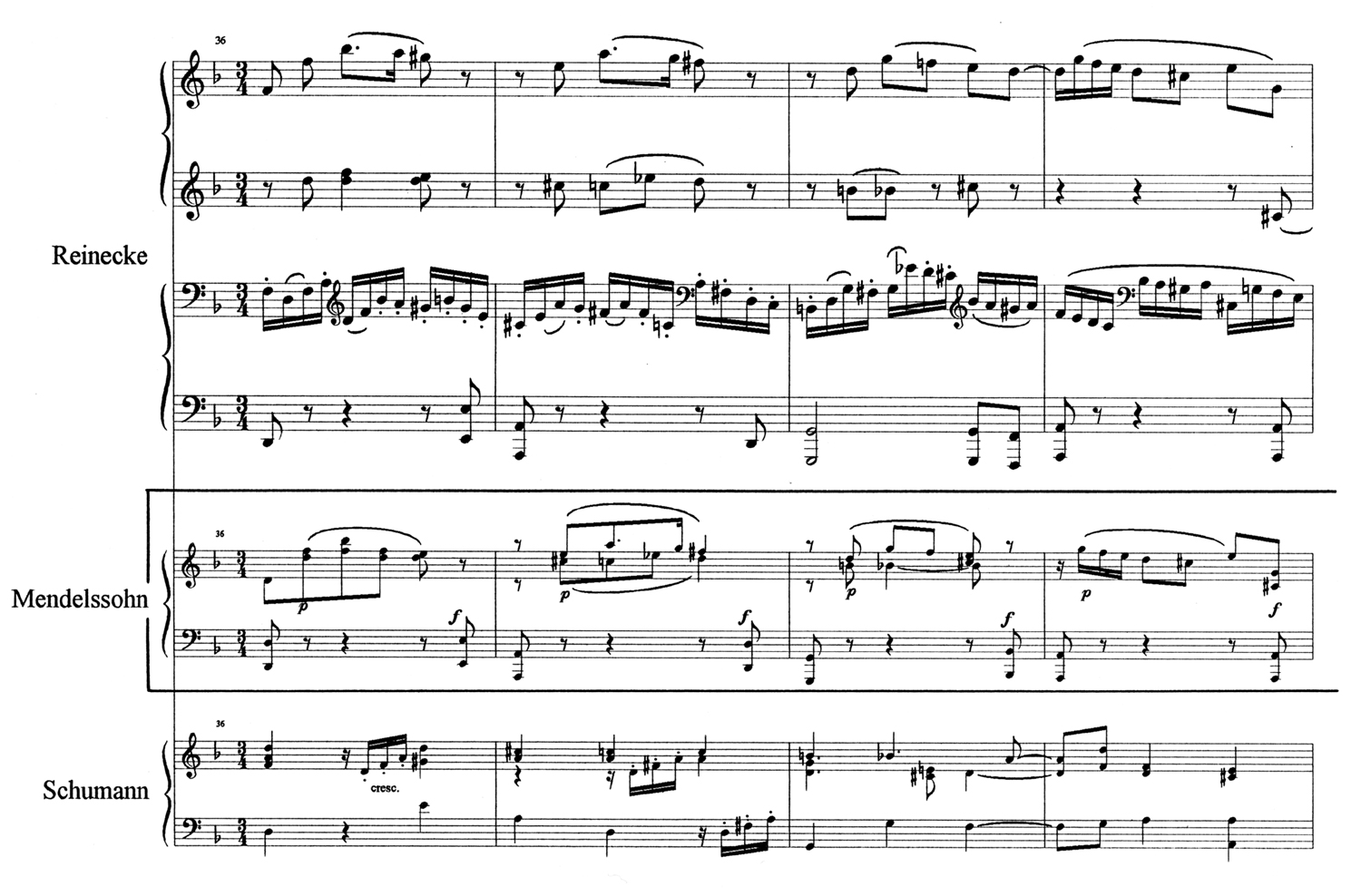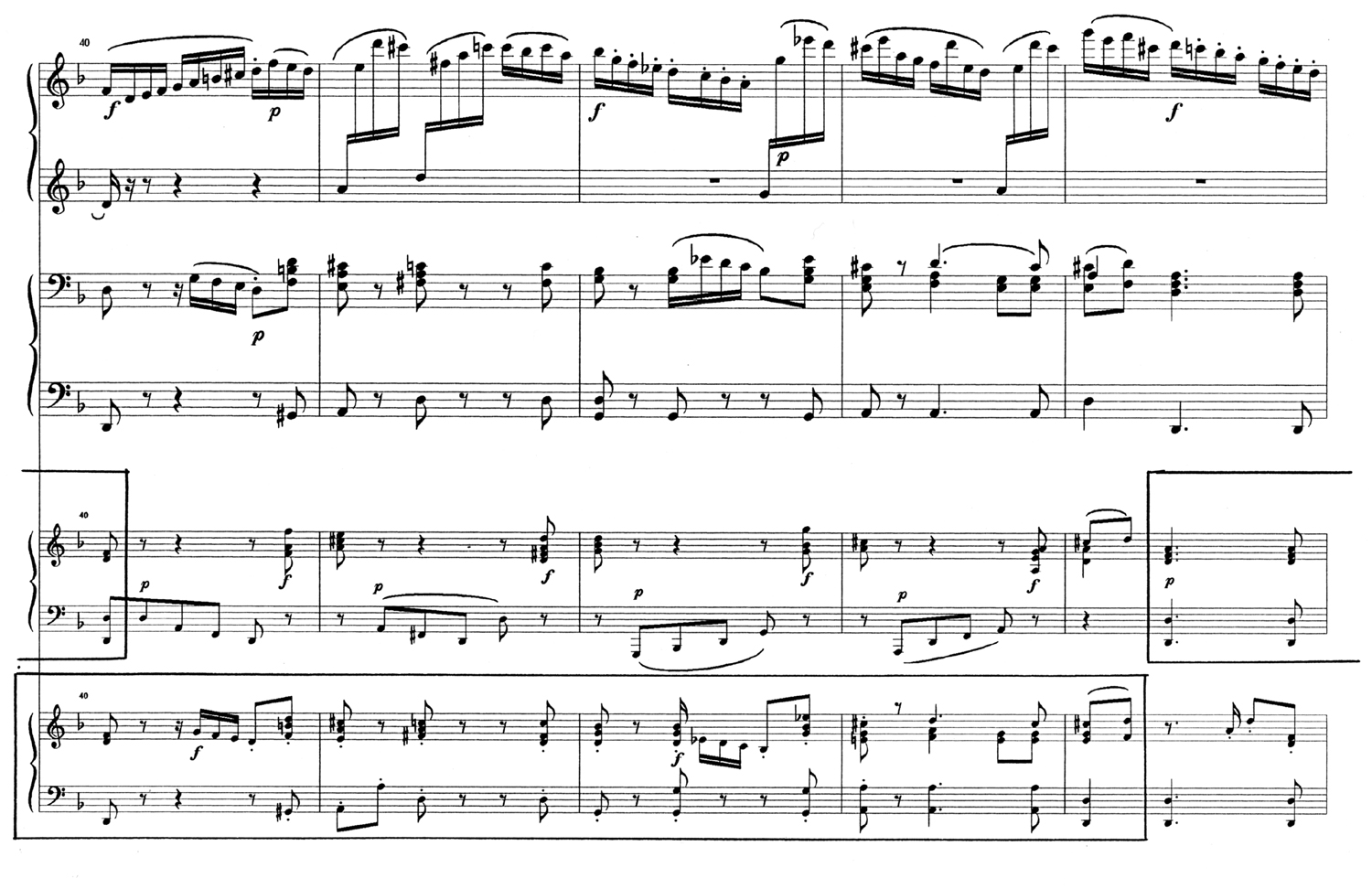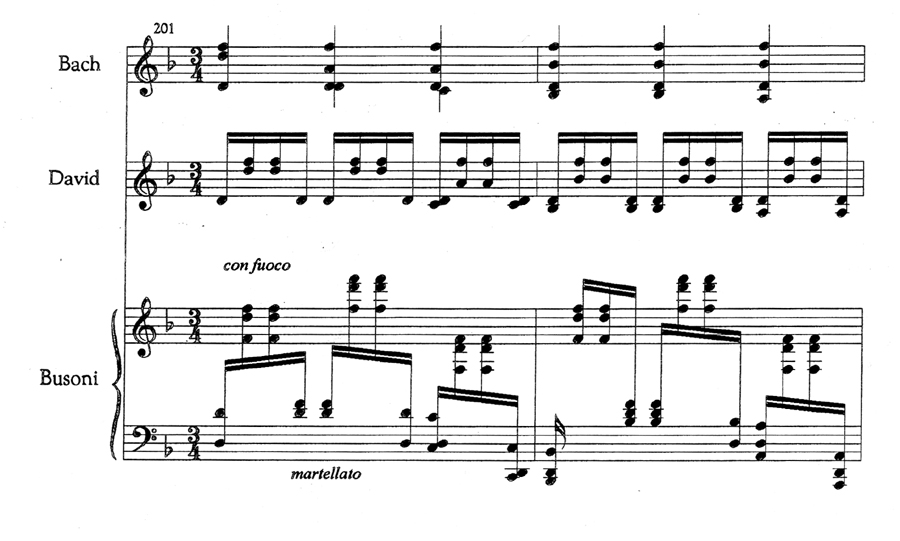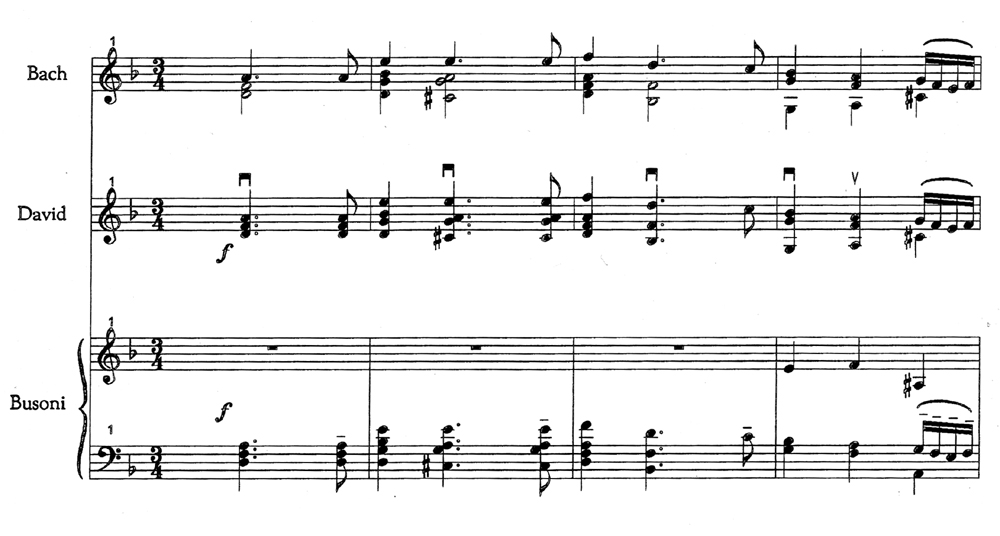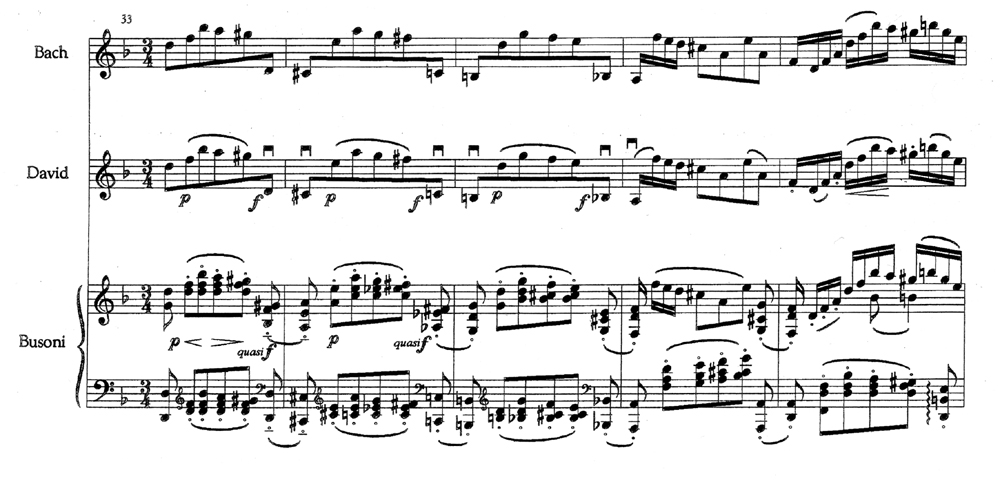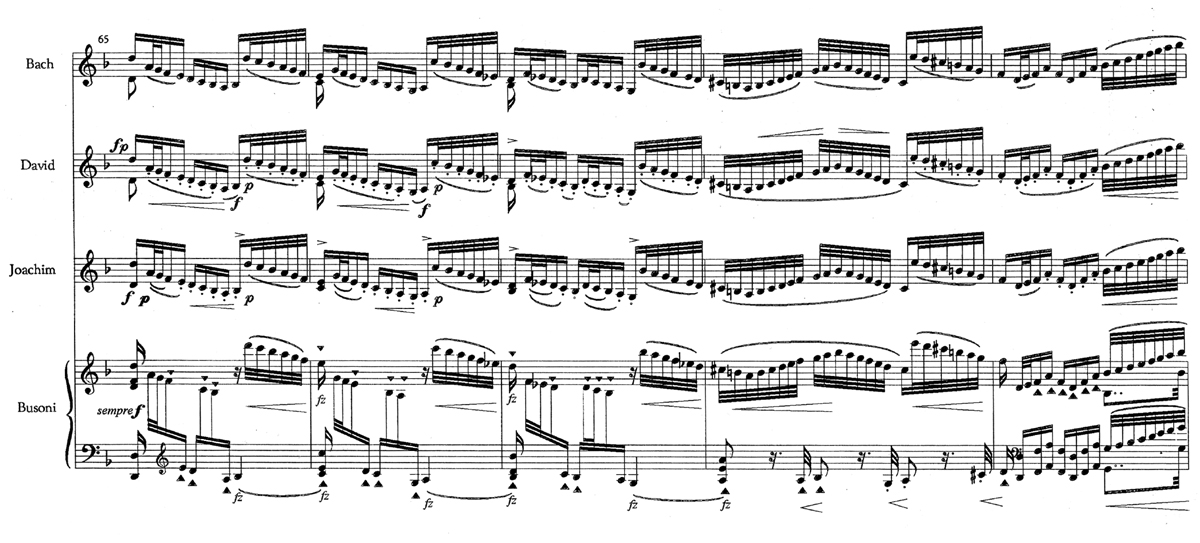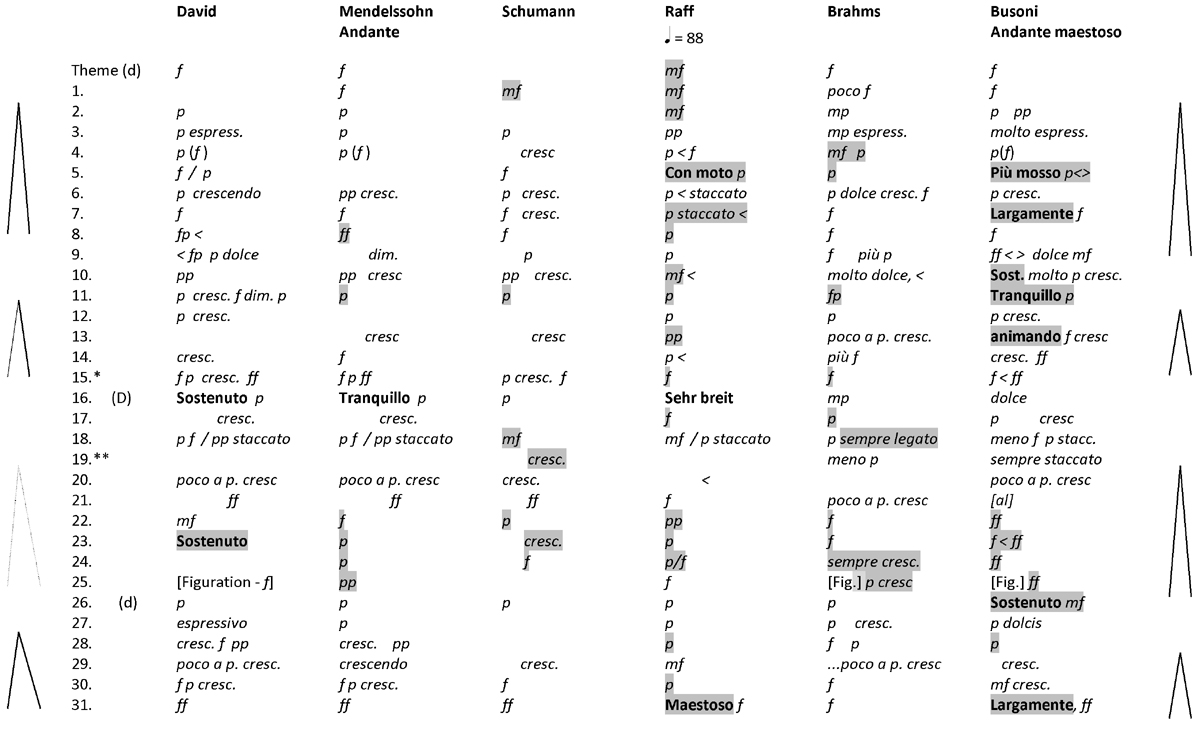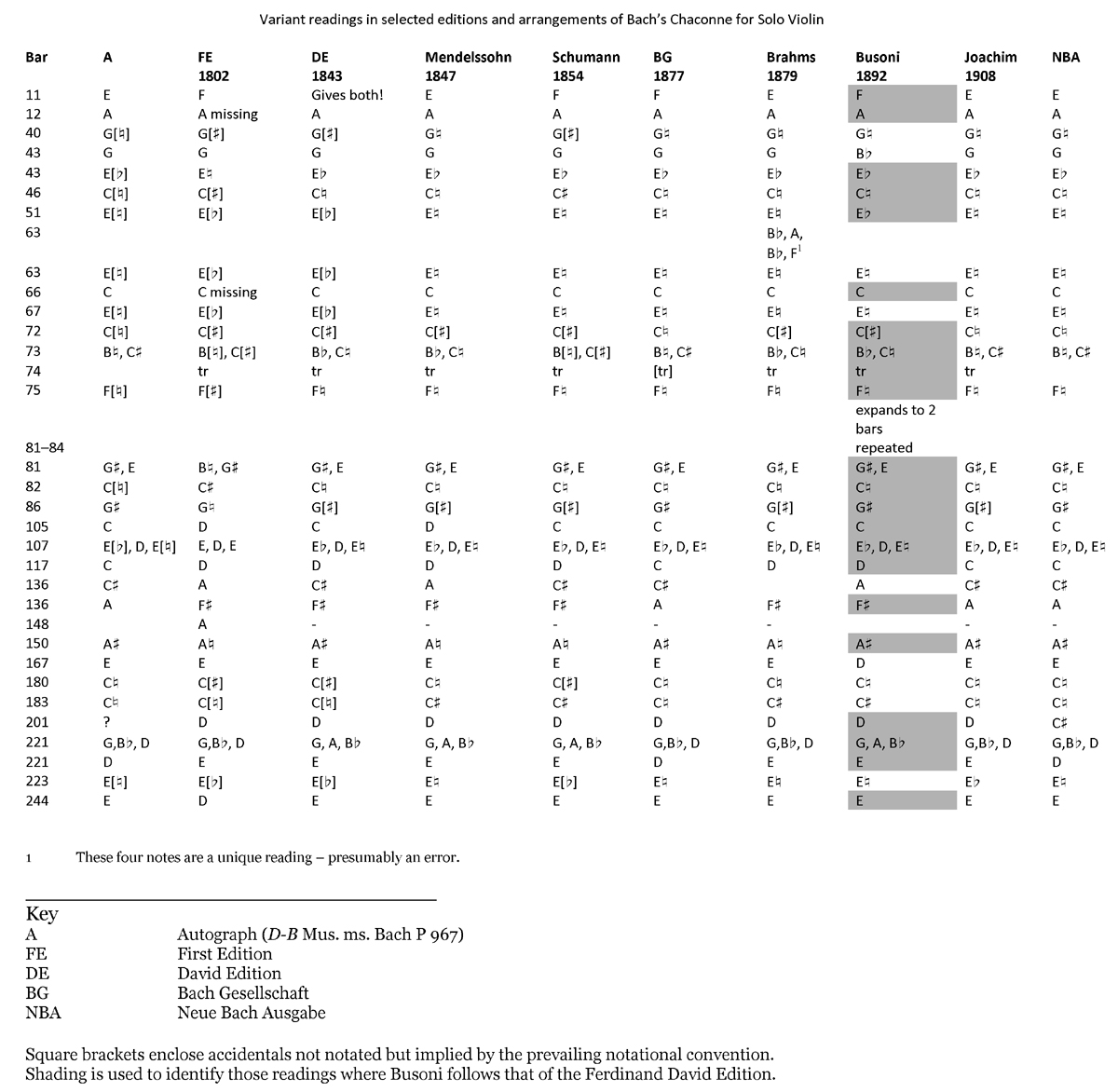[This short paper was given at the Ninth Conference on Nineteenth Century Music, held at Nottingham in 1996. It grew out of the research I undertook during the preparation of my edition of Busoni’s piano transcription of Bach’s Chaconne (London: Peters Edition, 1997).]
In 1935, in the preface to his orchestral version of the Chaconne from Bach’s Second Partita for unaccompanied violin (BWV1004), Alfredo Casella acknowledged that he had adopted a structural modification first employed by Busoni – a varied repeat of one of the variations – but added
I have to confess that Busoni’s famous pianoforte transcription does not have my unconditional admiration, quite the opposite.
Casella was not the last to have reservations about Busoni’s ‘arrangement’ for piano solo, and he was certainly not the first. One of the earliest was, perhaps surprisingly, the dedicatee, the pianist, composer and fellow Bach-arranger, Eugene d’Albert. Busoni had no very high opinion of d’Albert’s own music, but he did admire his piano playing, and the dedication of the Chaconne transcription was clearly an expression of that esteem. The work was published in late 1892 or early 1893 but it took d’Albert over a year to respond to the dedication. On 30 March 1894 he finally wrote to Busoni from Milan:
I played through your arrangement immediately on receipt, and it pleased me greatly, though, I must confess to you, not as much as your arrangement of the E♭ major Fugue.[1] I think the Chaconne won’t tolerate an arrangement for two hands. In my opinion the only solution is to be found in the Brahms arrangement for the left hand alone. Any other adaptation must be necessarily too modern and I find this to be the case with your arrangement. It’s something else to arrange an organ fugue – but a piece written for violin alone, conceived within the compass of the violin-clef, definitely looses by the introduction of basses and, for example, broken octave passages. This is my very humble opinion …[2]
Nearly two months later Busoni addressed these observations in a draft response to d’Albert. Whether these counter- arguments were ever included in a finished letter is not known, but they were elaborated in a passage in his essay Von der Ubertragung Bach’scher Orgelwerke auf das Pianoforte that appeared as the first appendix to his edition of Das wohltempirirte Klavier:[3]
In his transcriptions of the Preludes and Fugues in D, E♭ and E minor the editor has devoted much care to registration, and he refers to them as a collection of examples of this method. The piano transcription of the Chaconne for violin by the same master may be included in the series, in as much as the editor has in both cases treated tonal effects in an organistic sense. This procedure, which has been variously attacked, finds its justification chiefly in the meaningful content which cannot attain complete expression through the violin, and also in the example set by Bach in the characteristic organ transcription of his violin fugue in G minor.[4]
So Busoni imagined an organ transcription by Bach, and transcribed that for piano.
The purpose of this paper is not to give an detailed account of Busoni’s manipulations of the original, nor to address directly the aesthetic and critical issues they raise, but rather to relate Busoni’s version to the surprisingly extensive tradition of such arrangements, and a contemporary interpretative approach to the original version. As far as the arrangements are concerned, these have been chronicled in an article by Georg Feder [5] and I will not attempt anything like such a comprehensive survey: this account is limited to edited highlights.
Bach’s works for unaccompanied violin had circulated in manuscript copies in the 18th century, and it was not until 1802 that the first printed editions were published simultaneously in Paris and Bonn by Decombe and Simrock. The latter was reissued ca. 1825 in altered form, but it was probably not until the 1840s that the Chaconne began to assume a canonic status within the violin repertory. The crucial moment in that stage in its history was reported by Schumann in both the Neue Zeitschrift für Musik and in the Allgemeine Zeitung for 1 March 1840. The event he refers to was one of a series of evening chamber concerts given in Leipzig during the 1839–40 season, and this particular occasion included performances of movements from Bach’s works for unaccompanied violin, played by the leader of the Gewandhaus orchestra, Ferdinand David. In the Allgemeine Zeitung Schumann wrote:
David played the Chaconne by J.S. Bach, a piece from those sonatas for violin solo for which someone once asserted, wrongly, ‘it is impossible to conceive an additional part’,[6] a view that Mendelssohn-Bartholdy disproved in the best way, in that he accompanied it at the piano so wonderfully that the old, eternal cantor seemed to take a hand in it. That Bach himself thought of his piece like this or similarly, is perhaps possible … but he certainly never heard it in such perfection or masterly simplicity.[7]
According to Ferdinand Hiller, Mendelssohn accompanied ‘frei am Klavier’,[8] but in 1847 Cranz published an accompanied version of the Chaconne by Mendelssohn: to what extent this corresponds to the version heard in 1840 is not clear, but, Mendelssohn’s example was to be followed by a number of other composers.
As Table 1 makes clear, some of the arrangements – notably those by Mendelssohn, Schumann, Raff and Busoni – became themselves the starting point for a second level of transcription or arrangement. Particularly notable are those versions that combine the Mendelssohn and Schumann accompaniments. The earliest, by Reinecke, fails to acknowledge its borrowings, which are presented sequentially. Feder takes the view that Reinecke uses ‘in general the version that is the richest contrapuntally and smoothest in voice-leading, resulting in a slight preference for Mendelssohn’:
Ex. 1
Bach’s Chaconne arranged by Reinecke (1874), Mendelssohn (1840–7) & Schumann (1853)
On the other hand Luzzatto’s arrangement for two pianos relies more heavily on Schumann. But it was Michaud who came up with the most innovative approach – perhaps taking a cue from the Peters edition of the Chaconne first issued in the 1880s, which printed Bach’s original and the Mendelssohn and Schumann accompaniments one above the other – by presenting both accompaniments simultaneously at some points in his orchestration.
A feature common to all the versions in Table 1 – with the exception of Brahms’s – is that all went well beyond what would normally be understood by ‘arrangement’, and involved the creation of accompanimental figures and contrapuntal lines. In addition, all the ‘arrangers’ had to grapple with the absence of dynamic markings, relatively sparse indications of bowing and articulation, and the fact that Bach had left the realization of an arpeggiated passage to the performer.
In fact all these issues had already be addressed by Mendelssohn’s partner in the crucial 1840 performance of the Chaconne, Ferdinand David. This distinguished violinist played an important role in the disinterment of works from the early violin repertoire, though by the end of the nineteenth century his editorial practices were being strongly criticized:
Through irreverent alterations, addition of ornaments and fussy performance nuances, inclusion of cadenzas which strained against the character of the work in question, through the smuggling in of no end of subtle dynamic shadings, he adapted the works of the old masters completely to the taste of certain ‘modern’ people of his time, but in so doing, at the same time robbed those unpretentiously simple works of art of their characteristic magic and charm.[9]
The bluntness of these strong words, from Andreas Moser, the chief biographer of Joseph Joachim, are in themselves an indication of how significant David’s influence had been on later violinists. Indeed, it was David who had introduced Joachim to the unaccompanied works by Bach, thus preparing a corner-stone of the younger violinist’s concert repertoire.
Even Moser had to admit, though, that there was one partial exception to his strictures: David’s 1843 edition of Bach’s unaccompanied works, the first publication of the sonatas and partitas since 1825. It adopts the, for the time, unusual strategy of printing both a transcription of what was (wrongly) presumed to be the autograph and, above it, David’s performing version. So, at the very least, the nature and extent of David’s additions were clearly visible.
Ex. 3
Bach: Sechs Sonaten für die Violine allein …
mit Fingersatz, Bogenstrichen und sonstigen Bezeichnungen versehen von Ferd. David
(Leipzig: Bei Fr. Kistner, 1843)
It is perhaps an indication of both David’s authority, and his success in embodying contemporary taste, that his view of the appropriate bowing, phrasing, dynamic gradations and realizations of arpeggios proved to have a substantial influence of both editors and arrangers of the works for the rest of the century, and beyond. When, in the last year of his life, Joachim worked on his own edition of the unaccompanied works with Andreas Moser, he adopted exactly the same layout – though in his case he did have access to the autograph (which had not even been available to the editors of the Bach-Gesellschaft edition) – and his solutions to the various performance practice issues are not, for the most part, significantly different to David’s.
I am not in a position to chart in detail the impact of David’s edition on other editors of the Chaconne, nor on all of the arrangers, but comparison of David’s text and Busoni’s are illuminating. One notable point concerns the second arpeggiated passage, for the realization of which Bach himself gives no clue; David’s solution is the one adopted and transformed by Busoni:
Ex. 4
Bars 201–202 in Bach’s original notation and the realisations by David and Busoni
The opening offers another striking parallel. Here, against the obvious implication of Bach’s notation – and in contrast, for once, with Joachim – David adopts triple-stopped chords on the final quaver of the first two bars, a reading adopted by Busoni.
Ex. 5
Chaconne, bb. 1-4 in Bach’s notation, David’s edition and Busoni’s transcription
Elsewhere there are numerous examples of articulation and/or dynamic markings from David’s edition which are adopted, adapted and developed by Busoni. In the next example the contrast between the piano phrases and the f down bows appears in both, though Busoni does not exploit the legato/detached contrast created by David. (This example also shows something of Busoni’s imaginative freedom, with the melodic line of the earlier variation being repeated in the left hand, while the right hand begins the statement of Bach’s next variation.)
Ex. 6
Chaconne, bb. 33–37, showing Bach’s original, David’s edition and Busoni’s transcription
The last example shows how an articulation – in this case detached/staccato semiquavers in David and Joachim – is intensified, in this case to staccatissimo notes with wedges (rather than dots) in Busoni:
Ex. 7
Chaconne, bb. 65–9, showing Bach’s original, David’s edition and Busoni’s transcription
The dynamic markings show significant differences, a fact that is of some significance. As Table II shows, one of the most characteristic features of David’s edition was the way it uses dynamics and other markings to suggest structural units within the Chaconne that are made up from groups of variations, and the extent to which, in broad outline, a number of the later adaptations, including Busoni’s, adhere to David’s shaping of the piece.
Table II
A table comparing treatment of dynamics and tempo in the
David edition of the Chaconne, and the arrangements by Mendelssohn, Schumann, Raff, Brahms and Busoni
[To view a larger version, click on the image]
Although Busoni’s general dramatic design of the work is clearly modeled on that of his predecessor, there are even more of those ‘fussy performance nuances, cadenzas and dynamic shadings’ that worried Andreas Moser, than in other versions it is through profuse modifications of dynamics and tempo that Busoni heightens the shaping of the piece.
The ideal conclusion for the paper would be for me to produce incontrovertible proof that Busoni was using the David edition as a basis for expansion and elaboration in his transcription, but I am unable to do so. Indeed, a close examination of Bach’s text embodied in both versions shows that although they share some readings (and misreadings) there are significant divergences (see Table III). On the other hand, I think that the similarities identified earlier in this paper, point to some sort of connection.
Table III
Variant readings in selected editions and arrangements
[To view a larger version, click on the image]
In this connection the close similarities between the editions by David and Joachim are perhaps significant, an indication of the extent to which there was a shared, perhaps widely shared agreement about how the Chaconne should be performed. It is therefore notable that Busoni linked the two violinists in a comment about the performance of the Chaconne. In March 1915 he wrote to his pupil and colleague Egon Petri from Chicago, describing a concert he had attended out of politeness:
Middelschulte has transcribed Bach’s Chaconne for strings and organ. – The work is inadequate for such large forces and sounds thinner than on the piano. – The gentlemen of the violins occasionally obtruded when they lit upon the celebrated passages from the David and Joachim interpretations.[10]
That there is a slightly disparaging tone in the comment about ‘celebrated passages’ is not, in my view, as significant as the fact that the comment assumes the importance and familiarity of the two men’s interpretations. As I have tried to show, there is evidence that despite his reservations in 1915, either consciously or unconsciously Busoni had reflected aspects of the David-Joachim tradition in his own transcription of 1892.
The matter was discussed in more, and different detail in a slightly earlier letter Busoni wrote to his wife, immediately after the Chicago concert:
There are so many possibilities if one begins making variations with this piece, that it is difficult for a contrapuntalist to show why he has chosen one possibility rather than another. Whenever they came to a well-known passage, the violinists played in the style of a David or Joachim, which was always disturbing. . . . I saw that the Chaconne would not do for a big apparatus. It loses in bigness. It always sounds best transcribed for the piano…[11]
Well, that is controversial, and takes us on to aesthetic issues: it’s not so much an end for this paper, but the beginning of one as yet unwritten.

This website by Paul Banks is licensed under a Creative Commons Attribution-NonCommercial-ShareAlike 4.0 International License.
![]()
 orcid.org/0000-0002-2258-0267
orcid.org/0000-0002-2258-0267
Online resources
A colour facsimile of Bach’s autograph manuscript (D-B Mus. ms. Bach P 967) is available, as are scans of printed editions of the arrangements by Mendelssohn, Schumann, Raff, Brahms, Zichy, Busoni, and Luzzato (all provided by ISMLP)
Notes
1 Busoni’s transcription of the Prelude and Fugue in Eb for organ (BWV 552), first published by D. Rahter, probably in 1890 (J. Kindermann, Thematisch—chronologisches Verzeichnis der musikalischen Werke von Ferruccio B. Busoni (Regensburg: Gustav Bosse Verlag, 1980), B 22).
2 D-B Mus.ep. E. d’Albert 209 (Busoni Nachlaß). I am most grateful to Dr Jutta Theurich for drawing this letter, and the draft of Busoni’s response (see below) to my attention.
3 J.S.Bach, Das wohltemperierte Klavier, ed. Ferruccio Busoni, Book 1, volume 4 (Leipzig, Breitkopf & Härtel, 1894), p. 167.
4 Busoni is here referring to the Prelude and Fugue in D minor for organ (BWV 539), in which the fugue is based on the fugue from the first Sonata for unaccompanied violin (BWV 1001).
5 George Feder, ‘Geschichte der Bearbeitung von Bachs Chaconne’, Bach-Interpretationen, ed. Martin Geck, (Göttingen, 1969) 168-189.
6 The first such assertion was made by Kirnberger in 1774: Feder, op. cit. traces the history of this point of view.
7 Robert Schumann, Gesammelte Schriften über Musik und Musiker, 4th edition, ed. Martin Kreisig (Leipzig: Breitkopf & Härtel, 1914), II, p. 439.
8 Loc cit.
9 Andreas Moser Joseph Joachim: Ein Lebensbild (Berlin, B. Behr’s Verlag, 1898), I, p. 42.
10 Ferrucio Buson, Selected Letters, tr. and ed. by Antony Beaumont (London: faber and faber, 1987), p. 195. It is worth recalling that Petri’s father, Henri Petri, was a pupil of David.
11 Ferruccio Busoni, Letters to his Wife, tr. Rosamond Ley (London: Edward Arnold & Co., 1938), p. 251.



